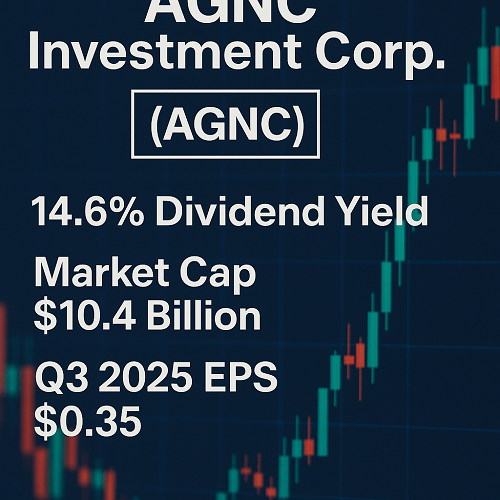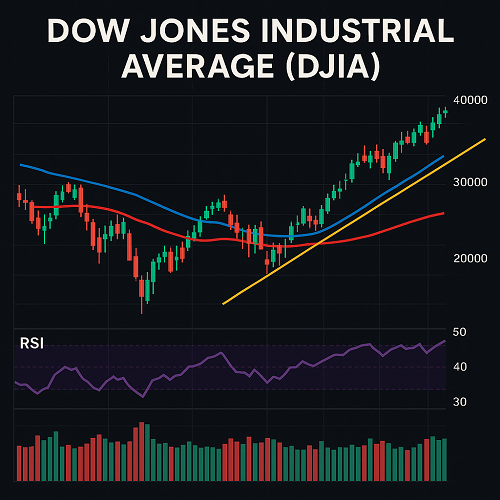What is AGNC Investment Corp?
AGNC Investment Corp. (ticker: AGNC), listed on NASDAQ, is a U.S. publicly-traded mortgage real estate investment trust (mREIT) that invests primarily in agency mortgage-backed securities (MBS) and collateralised mortgage obligations (CMOs) guaranteed by U.S. government-sponsored enterprises (GSEs) or agencies.
The company:
- Was founded in January 2008 and went public in May 2008.
- Has elected to be taxed as a REIT; therefore, it must distribute at least 90% of its taxable income to shareholders to maintain the tax-advantaged structure.
- Is headquartered in Bethesda, Maryland. S
How AGNC makes money
AGNC generates net interest income by borrowing at short-term or mid-term rates and investing in longer-duration agency MBS and CMOs. The spread between funding costs and yield on assets is the primary driver of earnings and dividends. Because agency MBS are guaranteed by GSEs or agencies, credit risk is relatively low, but the business is highly sensitive to interest‐rate changes, spread compression, convexity risk, and portfolio leverage.
Key structural facts
- Monthly dividend payments: AGNC issues monthly common stock dividends (e.g., US $0.12 per share monthly as of 2025).
- High dividend yield (more on this later), which positions it as an income-vehicle rather than a growth stock.
- Because the portfolio’s value and yield are tied to interest rates and prepayment behaviour, volatility is high compared to many REITs that own physical properties.
Recent Events & Q3 2025 Earnings Snapshot
Q3 2025 earnings performance
In early October 2025, AGNC reported for Q3: profit of US $806 million, or US $0.72 per share. Adjusted for non-recurring items, EPS came in at around US $0.35 per share.
While the headline EPS looks strong, investors should note:
- The adjustment from US $0.72 to US $0.35 suggests the presence of one-time gains.
- Even with a strong quarter, the bigger driver remains net interest margin and portfolio mark-to-market (M2M) movements in MBS.
- The announcement coincides with a maintained monthly dividend of US $0.12 per share, signaling management’s commitment to income continuity.
Recent corporate actions & news
- AGNC launched three agency MBS indices in partnership with Intercontinental Exchange, Inc. (ICE) in October 2025, an indication of the firm’s efforts to build data/analytics assets alongside its investment portfolio.
- Monthly dividend declarations consistently at US $0.12 per share from January to September 2025. AGNC Investment Corp.+1
Why it matters for traders/investors
- The large quarterly profit signals that AGNC continues to execute despite interest-rate headwinds.
- The new index initiative suggests diversification of revenue or at least brand/market presence in the mortgage-securities space.
- For traders, such news can prompt re-rating or short-term momentum as yield traders adjust positions ahead of rate changes.
Dividend Profile: Yield, Sustainability & Risks
Yield breakdown
- The current dividend per share is US $0.12 monthly (so ~US $1.44 annually).
- That equates to a dividend yield of ~14–16% (depending on share price) which is far above typical real-estate sector averages (the REIT sector average is approx ~6.6%).
- Example: Some sources report a yield of ~14.41% with a payout ratio of ~464.5% (based on simplified metrics) as of late 2025.
Is the yield sustainable?
Key factors to evaluate:
Pros:
- Agency MBS have low credit risk (due to GSE/agency guarantees).
- AGNC has maintained the US $0.12 monthly payout for many months, indicating a strong desire to keep the dividend stable.
Cons / Risks:
- A payout ratio above 100% (in some metrics, 300–600%+) signals that dividends are not being covered by cash earnings alone; some is funded by leverage or mark-to-market gains.
- Interest rates: If short-term rates rise or yield curve moves unfavourably (e.g., flattening/inversion), the spread between asset incomes and funding costs can compress.
- Prepayment and extension risk: With mortgage-backed securities, faster prepayments reduce yield/leverage, slower ones increase duration risk.
- Leverage risk: mREITs often use significant borrowing; the cost of leverage matters.
- Regulatory and tax risk: As a REIT, it must distribute a high proportion of taxable income. Any earnings weakness can threaten payout.
Historical dividend consistency
AGNC has paid US $0.12 per share monthly consistently from at least January 2021 through 2025.
This consistency is positive, but the real question is whether the dividend is being supported by recurring earnings or by accounting mark-to-market gains.
What yield-seekers should ask
- “Is the yield too good to be true?” — A 14%+ yield is rare; one must assess sustainability.
- “What is the underlying net interest margin (NIM)?” — Since mREITs rely on spread.
- “What is AGNC’s leverage and hedging strategy?” — Because rate or spread moves can hit their return hard.
- “What is the payout ratio and how is it funded?” — Since above-100% payout ratio raises red flags.
Rate Environment & Interest-Rate Risk
Why interest rates matter to AGNC
AGNC’s business model is heavily rate-sensitive because:
- It borrows (funds) at shorter/mid-term interest rates, then invests in longer-duration agency MBS → The spread between investment yield and funding cost is the core driver.
- Changes in the yield curve (steepening, flattening, inversion) affect future asset yield, prepayment/extension risk, and portfolio valuation (mark-to-market).
- Duration risk: If the Fed (Federal Reserve) cuts rates, long‐term yields may drop, which might benefit MBS valuations but potentially harm future income. If rates rise, funding costs rise and duration risk increases.
Current backdrop (2025)
- With inflation elevated and rate-cut expectations variable, fixed‐income markets are volatile; mREITs like AGNC remain under pressure from funding costs and margin compression.
- Some analysts view a future rate cut as a catalyst: A drop in short‐term funding rates would improve the spread for AGNC. Indeed, some commentary flagged this as a potential upside.
Specific risks/trade-offs
- If long-term yields rise faster than the portfolio can re-invest, AGNC may see asset value decline and earnings hit.
- Prepayment risk: In a falling-rate environment, homeowners may refinance faster, reducing yields on the portfolio.
- Hedging cost: Many mREITs hedge interest-rate exposure; hedging cost can eat into returns, especially in volatile markets.
- Funding risk: If short-term rates stay high, borrowing costs remain elevated and spread shrinks.
Trading implication
- For traders: Rate changes and Fed announcements are key catalysts. A surprise rate cut could spark a rally; a surprise rate hike or stronger inflation could trigger a sell-off.
- For income investors: Understanding the snapshot of margins and portfolio reinvestment yield is critical — you’re betting on the spread, not on equity growth.
Valuation Metrics & Peer Comparison
Valuation snapshot
Using data from Simply Wall St:
- Market cap approx US $10.41 billion.
- Revenue (TTM) US $496 million; Earnings (TTM) US $236 million.
- Based on those numbers, the P/E ratio appears elevated (but note mREITs often have distorted earnings due to mark‐to‐market).
Dividend yield vs sector
- AGNC’s dividend yield (~14-16%) is ~2–3x higher than the average REIT (≈6.6%).
- However, higher yield comes with higher risk.
Peer comparison
- NLY (Annaly Capital Management, peer mREIT) has a yield ~14.87%.
- Other mortgage REITs often yield even higher but may carry even more risk.
Key metrics to evaluate
- Net interest margin (NIM): How wide is the spread between yields on assets and funding cost?
- Book value / NAV: For mREITs, comparing market price vs NAV can indicate whether the market is pricing in trouble.
- Leverage ratio: Higher leverage increases risk (amplifies both gains & losses).
- Payout coverage: Is the dividend covered by earnings or is it propped up by mark-to-market gains/borrowing?
- Interest-rate hedging cost: Are hedges costly and eroding returns?
SWOT Analysis
Strengths
- Very high yield – compelling for income-seeking investors/portfolio managers.
- Exposure to agency MBS with lower credit risk (because of GSE/agency guarantee).
- Monthly dividend offers a consistent cash flow cadence.
- Corporate initiatives (e.g., index launches) suggest management seeking diversified income streams.
Weaknesses
- Highly interest-rate sensitive: Margins can compress quickly.
- Dividend payout appears to be greater than earnings in some metrics — may be sustained only with favourable rate environment.
- Volatility is high, making it less suited for investors seeking stability.
- NAV/valuation risk: If the portfolio is marked down, shareholders bear losses.
Opportunities
- If the Fed cuts rates or the yield curve steepens favourably, AGNC could benefit significantly.
- Reinvestment of capital into higher‐yielding assets if rates stay elevated.
- Wider adoption of mortgage-securities indices (via ICE partnership) may open new revenue lines.
- For traders: Volatility in rates/mortgages = event-driven opportunities.
Threats
- A sustained high interest‐rate environment or a hawkish Fed could destroy spread and cause portfolio losses.
- Prepayment risk if mortgage refis surge in falling-rate environment — reduces yield and reinvestment opportunities.
- Leverage lines: If funding costs spike or credit spreads widen, the business could face margin pressure or forced deleveraging.
- Regulation/tax: REIT status requires 90% distribution; inability to meet this could trigger tax issues.
Trading Strategies: Short-term & Long-term Considerations
Long-Term Income Investor
If you’re looking at AGNC for income:
- Target yield-driven allocation: AGNC can be part of a yield portfolio, but only if you’re comfortable with elevated risk.
- Diversify: Don’t allocate a large % of your portfolio solely to one mREIT; combine with lower-volatility income plays.
- Monitor key metrics monthly: Funding cost, NIM, leverage, NAV, dividend sustainability.
- Dividend reinvestment (DRIP): Because yield is so high, reinvesting could provide strong compounding over time—but only if business remains healthy.
- Stop-loss / risk control: Since volatility is high, set clear rules for when to cut losses.
Short-Term / Trading Approach
- Event-driven trading: Fed announcements, rate changes, mortgage data releases affect mREITs. AGNC may move sharply on such events.
- Technical levels: Use support/resistance on AGNC’s chart (not provided here) to define entry/exit.
- Volatility trading: Consider hedging or option strategies if available to capture fast moves or protect downside.
- Yield curve plays: If you anticipate rates will fall or the curve will steepen, AGNC is a candidate for upside; if not, it’s high risk.
- Watch liquidity / spread: In times of stress the bid/ask spreads may widen.
Frequently Asked Questions (FAQs)
Q: What is AGNC’s current dividend yield?
A: Around 14–16% based on recent payout of US $0.12 per share monthly (≈US $1.44 annually) and prior share-price ranges.
Q: Is the dividend safe?
A: It is relatively consistent, but not without risk. Payout coverage appears stretched (>100% in some data), so the dividend is vulnerable to adverse rate or portfolio events.
Q: What drives AGNC’s earnings?
A: Primarily the spread between funding costs and asset yield on agency MBS/CMOs, portfolio mark-to-market valuations, prepayment/extension risk, and leverage costs.
Q: How does interest-rate risk affect AGNC?
A: If funding costs rise or yield spreads compress, earnings and dividends can drop. Conversely, a rate cut may improve spread and boost valuation. Duration risk (longer maturity assets) also matters.
Q: How does AGNC compare to other REITs?
A: Yield is much higher than typical property REITs, but risk is also much higher. Unlike property REITs that rely on rents, AGNC relies on mortgage-securities spreads and rates.
Q: Is this suitable for conservative investors?
A: Probably not. The high yield comes with elevated risk and volatility. Conservative investors may prefer lower-yielding but more stable REITs.
Summary & Final Verdict
AGNC Investment Corp offers one of the most compelling yields in the REIT universe — 14 %+ in some cases — making it attractive to income-focused investors and yield-hungry traders. However, the high yield is a double-edged sword: it comes with significant interest-rate, duration, leverage and reinvestment risks that require a strong appetite for volatility.
For the long-term income investor with a tolerance for risk, AGNC can be a useful addition to a diversified yield portfolio — but not as a standalone. For the active trader, AGNC offers fast moves around macro events (Fed decisions, rate data, mortgage outlook). The key is monitoring the spread, leverage, dividend sustainability and rate environment continuously.
Final verdict: High reward but high risk. Use as part of an informed strategy, not as a passive “buy and forget” income stock.




 XAUT-USD
XAUT-USD  AMD
AMD  MARA
MARA  SHOP
SHOP  BULL
BULL  CL=F
CL=F